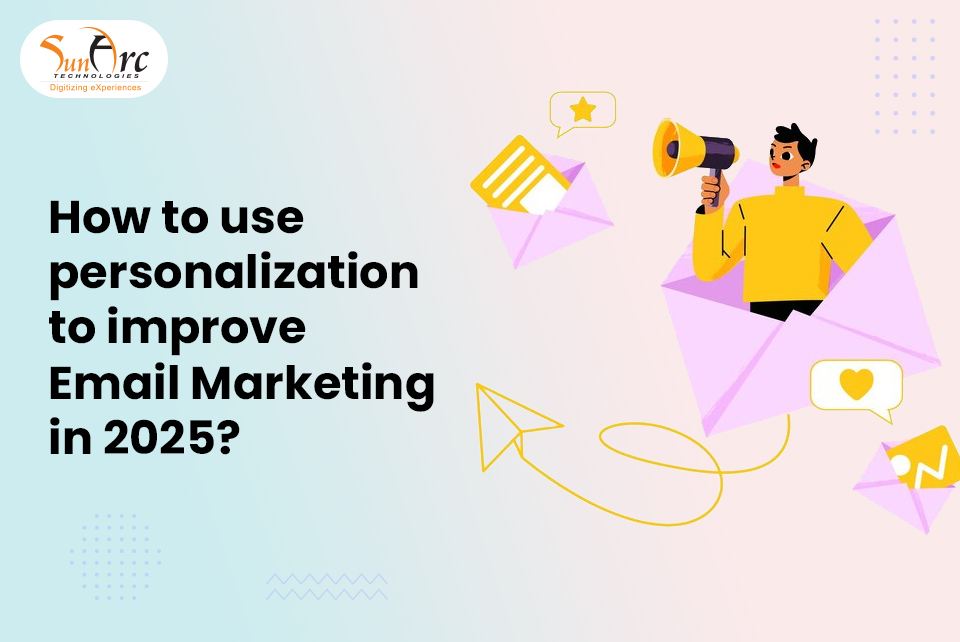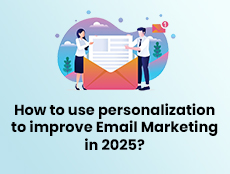Inboxes today are overflowing. The average person receives over 120 emails a day, and most of those go unopened, skimmed, or worse, straight to trash. So how do you break through the noise?
Simple: stop shouting at your entire list and start talking to people like you know them.
That’s what personalization is all about. And in 2025, it’s not just a nice-to-have, it’s table stakes.
Consumers have come to expect it. In fact, according to a recent Accenture report, 91% of people are more likely to shop with brands that offer relevant offers and recommendations. Experian also found that personalized emails can generate six times more transactions than generic ones. And brands using advanced personalization are seeing real ROI growth, some upwards of 20% or more.
So if you’re still sending the same message to everyone, you’re missing out. Let’s dive into how to use personalization effectively in your email strategy this year.

Why is Personalization More Important Than Ever?
Personalization used to mean adding someone’s first name to the subject line. That’s still useful, but now it’s just scratching the surface. Today’s tools allow us to create full-blown one-on-one conversations at scale.
Done right, personalization makes your emails feel less like marketing and more like service. It shows that you understand who your subscribers are, what they need, and when they need it.
And when your emails feel relevant, people open them. They click. They convert.
The Different Levels of Personalization (And How to Use Each One)
1. Basic Personalization : A Good Starting Point
This is where most brands begin. It includes using a person’s first name in the greeting or subject line, referencing their location, or personalizing the sender’s name.
Simple? Yes. But still effective. Including a first name in the subject line can boost open rates by over 25%, according to Campaign Monitor.
For example:
- “Your April picks are here, Julia”
- “We found something perfect for you in San Francisco”
It’s small, but it helps create a sense of familiarity.
2. Behavioral Personalization: Based on What People Do
Now we’re getting into more powerful territory. This is where you tailor emails based on someone’s actual behavior like what they viewed, clicked on, or purchased.
Let’s say a customer browses a few items on your site but doesn’t check out. You could send a follow-up email with a reminder or discount for those exact items.
Or if someone buys a skincare product, you might recommend a moisturizer that pairs well with it a week later.
This kind of personalization shows your audience that you’re paying attention and makes it more likely they’ll take the next step.
Netflix is a great example. If you stop halfway through a series, you’ll get a gentle nudge to continue not with a generic reminder, but with the exact title and even a preview image.
3. Demographic Personalization: Based on Who They Are
Demographics aren’t just for ad targeting. You can use them to personalize email content in ways that feel thoughtful and relevant.
For example, if you run an apparel brand and you know a subscriber is male, you probably want to highlight men’s clothing in your emails. If you know someone is in their 50s, your tone and product recommendations might look different than for a 22-year-old.
This applies across industries. A travel agency might promote luxury tours to older professionals, and budget-friendly adventure trips to students.
It’s not about stereotyping, it’s about being smart and respectful with what you know.
4. Contextual Personalization: Based on Current Circumstances
This is where you start using real-time data to make emails even more relevant.
For example, if it’s raining in New York, send umbrella and raincoat recommendations to subscribers in that area. If someone always opens your emails on their phone, make sure they see a mobile-friendly design and streamlined content.
Time of day matters, too. Someone who opens emails at 7 a.m. might be more responsive to calm, informative messages. Someone opening at 11 p.m.? They might be in browsing mode and ready for something more visual or entertaining.
Context adds depth to your personalization strategy and makes your emails feel timely, not random.
5. Predictive Personalization: Anticipating What Comes Next
Thanks to AI and machine learning, we can now go beyond reacting to customer behavior, we can predict it.
For example:
- You can estimate when someone is likely to reorder and send a friendly reminder right before they run out.
- You can identify which products a subscriber is most likely to buy next and recommend them proactively.
- You can detect patterns in email engagement and adjust how often you send messages, reducing fatigue while staying top-of-mind.
Platforms like Klaviyo and Salesforce use predictive analytics to do this behind the scenes, so you’re not guessing, you’re working from insights.
Personalization Strategies That Work in 2025
Rethink Segmentation: Go Beyond the Basics
Segmentation is the foundation of personalization. But don’t stop at demographics.
Segment by:
- Purchase frequency (weekly buyers vs. occasional ones)
- Customer lifetime value (treat your top spenders like VIPs)
- Engagement level (frequent openers vs. those who haven’t clicked in months)
This allows you to design specific journeys for each group instead of relying on a one-size-fits-all approach.
Use Dynamic Content Blocks
Instead of building 10 different emails, create one template with smart content blocks that adjust based on the recipient.
For instance, a fashion retailer can show summer styles to subscribers in warm regions and winter coats to those in colder climates all within the same campaign.
Or a software company can show enterprise-focused content to decision-makers, and how-to guides to users.
It’s efficient and incredibly effective.
Let AI Lend a Hand
AI can help you go deeper with personalization and do it faster.
You can use it to:
- Write different subject lines based on tone preferences or past behavior
- Recommend products based on browsing and purchase history
- Identify which images or layouts work best for each segment
This doesn’t replace the human touch it enhances it.
Optimize Send Times for Each Person
Send time optimization uses past behavior to figure out when each subscriber is most likely to open an email. Not everyone reads emails at 9 a.m.
Some email tools now adjust send times automatically. This small shift can lead to significant lifts in engagement and conversions.
Build a Feedback Loop
The best way to improve personalization? Ask your audience what they want.
Include options in your emails for people to set preferences:
- How often they want to hear from you
- What topics interest them most
- What type of products they care about
You can also use micro-surveys and A/B testing to learn what resonates. Then use that data to refine future emails.
Measuring Your Results
Personalization is powerful, but you still need to track how well it’s working. Focus on metrics that tell the full story:
- Open rates: Are people interested in your subject lines?
- Click-through rates: Is your content engaging?
- Conversion rates: Are you driving action?
- Unsubscribe rates: Are you striking the right balance?
Watch these over time, and always test new ideas to keep improving.
Tools to Help You Personalize at Scale
Here are a few platforms making it easier to deliver personalized experiences in 2025:
Klaviyo – Great for ecommerce brands with deep customer insights
ActiveCampaign – Combines automation with dynamic content and CRM integration
Litmus Personalize – Helps tailor content based on real-time factors like weather or location
Mailmodo – Makes interactive, personalized emails that feel like mini landing pages
Salesforce Marketing Cloud – Enterprise-level capabilities for large-scale campaigns
Final Thoughts
People are craving more meaningful digital experiences. Your emails don’t need to be flashy, they just need to feel like they were created with care.
Personalization isn’t about tricking your audience. It’s about respecting their time, understanding their needs, and delivering value in every interaction.
The brands that win in 2025 won’t be the ones sending the most emails. They’ll be the ones sending the most relevant ones.
If you’re ready to take your email strategy to the next level, personalization is your best starting point.
Need help? Contact us.

